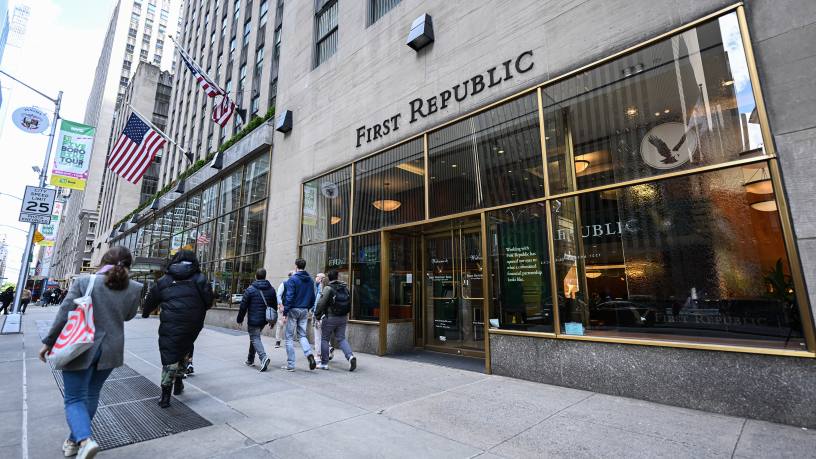Four US banking failures – Silicon Valley Bank, Silvergate Capital, Signature Bank and now First Republic Bank – in a matter of months. Many are now hoping that JPMorgan Chase’s $10.6bn acquisition of most of First Republic’s assets and deposits marks the end of a disturbing chapter in US banking history.
The sale of First Republic was brokered by the US Federal Deposit Insurance Corporation (FDIC) over the weekend, just hours after First Republic was seized by regulators, making it the second largest bank failure in US history. The sale to JPMorgan Chase put an end to months of speculation regarding the San Francisco-based lender’s future.
The FDIC went for, it says, the “least cost” resolution following a “highly competitive bidding process” for First Republic’s deposits and assets. JPMorgan estimates that the acquired portfolio of securities and loans will add more than $500m of annual net income, versus 2022 firm-wide net income of roughly $37.7bn, though S&P Global Ratings says this figure may be on the conservative side.
The biggest beneficiary from the acquisition will be JPMorgan’s wealth management business, adding roughly $290bn of First Republic’s wealth management assets – approximately 11% of the current size of JPMorgan’s wealth management business, according to S&P Global Ratings.
Although shareholders were wiped out by the deal, S&P analysts believe the risk for potential litigation is mitigated to some degree by the fact that First Republic’s assets and liabilities were acquired from receivership.
The possibility of greater-than-expected employee and client attrition are also viewed as less likely, says S&P Global Ratings, given the strength of the JPMorgan franchise.
Why did First Republic Bank fail?
But how did we get here? In March, following the collapse of Silicon Valley Bank (SVB), Signature Bank and Silvergate Capital, JPMorgan led a group of 11 US banks, including Bank of America, Wells Fargo, Citigroup and Trust Financial, which deposited $30bn in First Republic in an unprecedented rescue package.
In the end, however, the downfall of the US’s 14th largest bank was attributed to a combination of factors, including the contagion effect from the collapse of the other mid-sized US regional banks and characteristics unique to First Republic’s business and operating model.
First Republic’s first quarter results, which it announced on April 24, highlighted the extent of the bank’s problems – first quarter deposits, totalling $104.5bn, were 35.5% down year on year, declining 41% from December 2022.
The interest rate environment in which these loans were underwritten versus where we are now was just not sustainable
To add to the bank’s problems, its loan book comprised fixed-rate ‘jumbo mortgages’ to wealthy customers, offered at ‘bargain basement rates’. But once the Federal Reserve started aggressively hiking interest rates, these loans soon became a problem for the bank.
“The interest rate environment in which these loans were underwritten versus where we are now was just not sustainable,” explains Chris Wolfe, head of North American banks, Fitch Ratings. “There was always going to be some kind of hole in their balance sheet and unless that was fixed, depositors were always going to be fairly jittery.”
John Mackerey, senior vice-president for credit ratings, North American financial institutions at DBRS Morningstar, says First Republic was certainly an outlier for both deposit outflows as well as impact on earnings, he says. “They seem to be the one that was most under pressure, which does give us some comfort that the bulk of this is behind us now.”
Rapid deposit growth
But one thing that SVB, Signature Bank and First Republic all had in common, he says, is that their deposit bases grew fairly rapidly.
From year-end 2019 to year-end 2022, deposits for all FDIC-insured institutions grew by 32%. But SVB’s deposit growth for the same period was 179%, Signature Bank’s was 119% and First Republic’s 96%, says Mr Mackerey.
Diversity of funding and customers are likely to be key takeaways from the recent banking collapses in any future reviews of this troubled chapter in US banking history. All four banks targeted specific customer segments (crypto, wealthy clients, tech start-ups). But does JPMorgan’s acquisition of First Republic put an end to what has been a challenging two months for US regional banks?
Read more about the Banking Saga
“I think it ends the acute phase of the very rapid loss of confidence in a particular institution that happens in hours,” says Mr Wolfe of Fitch Ratings. “But now comes the harder part in terms of what happens next.”
Fitch Ratings’ outlook for the US banking sector, which it changed in November, already anticipated a difficult year for the industry.
“You can think of it as a regime change,” says Mr Wolfe. “Rates went from almost zero to 5% very rapidly and so there’s a lot of adjustments that come with that, liquidity being one of them. The Federal Reserve and other central banks not only raised rates, but at the same time reduced the money supply through quantitative tightening. That maybe isn't as fully appreciated by many, but deposit levels in the banking system are shrinking. We thought all along that was going to translate into higher deposit costs.”
US banking deposits are still shrinking, says Mr Wolfe, but not at the same magnitude as they were in mid-March.
Credit quality concerns
But US banks are likely to face additional economic and regulatory headwinds in the coming months. The regulatory noose is expected to tighten on mid-sized regional US banks in the wake of the recent failures, which Mr Mackerey anticipates will fuel further consolidation of US regional mid-sized banks.
“The economies of scale needed for the investments they will have to make for regulatory compliance will drive deals,” says Mr Mackerey. “That’s what drove the the BB&T and SunTrust merger, creating Truist Bank.”
One thing to be watched closely is asset quality, says Mr Mackerey. “Higher rates will impact certain businesses, which could lead to weakening asset quality. We don’t see an immediate worsening of asset quality, but that could play out over time.”
Stuart Plesser, US banking analyst at S&P Global Ratings, does not think there are any other large banks that have to be purchased in the short term. But there are other pressures, he says, around commercial real estate (CRE) and credit quality in general in a pressured profitability environment.
“Most of the large banks don’t have more than 15% CRE exposure,” he says. “Some regional banks we rate have more than 30% of CRE loans, but only 25% of those loans relate to office space. Even if significant losses in office occur, it’s not going to wipe away the capital of banks we rate. If banks are profitable they should be able to build reserves to cover loan losses. Still, it’s uncertain how depositors will behave if CRE losses escalate as banks have high market confidence sensitivity.”
In the first quarter, US banks increased their reserves for loan losses, particularly for CRE.
“Some banks disclosed [the] reserves they’d put aside for certain portfolios such as office, where they're in the 7% to 8% range,” says Mr Mackerey. “So banks are aware of the potential problems, especially with vacancy rates and higher interest rates impacting that portfolio, but they’re doing the right thing to prepare for a weakening.”













